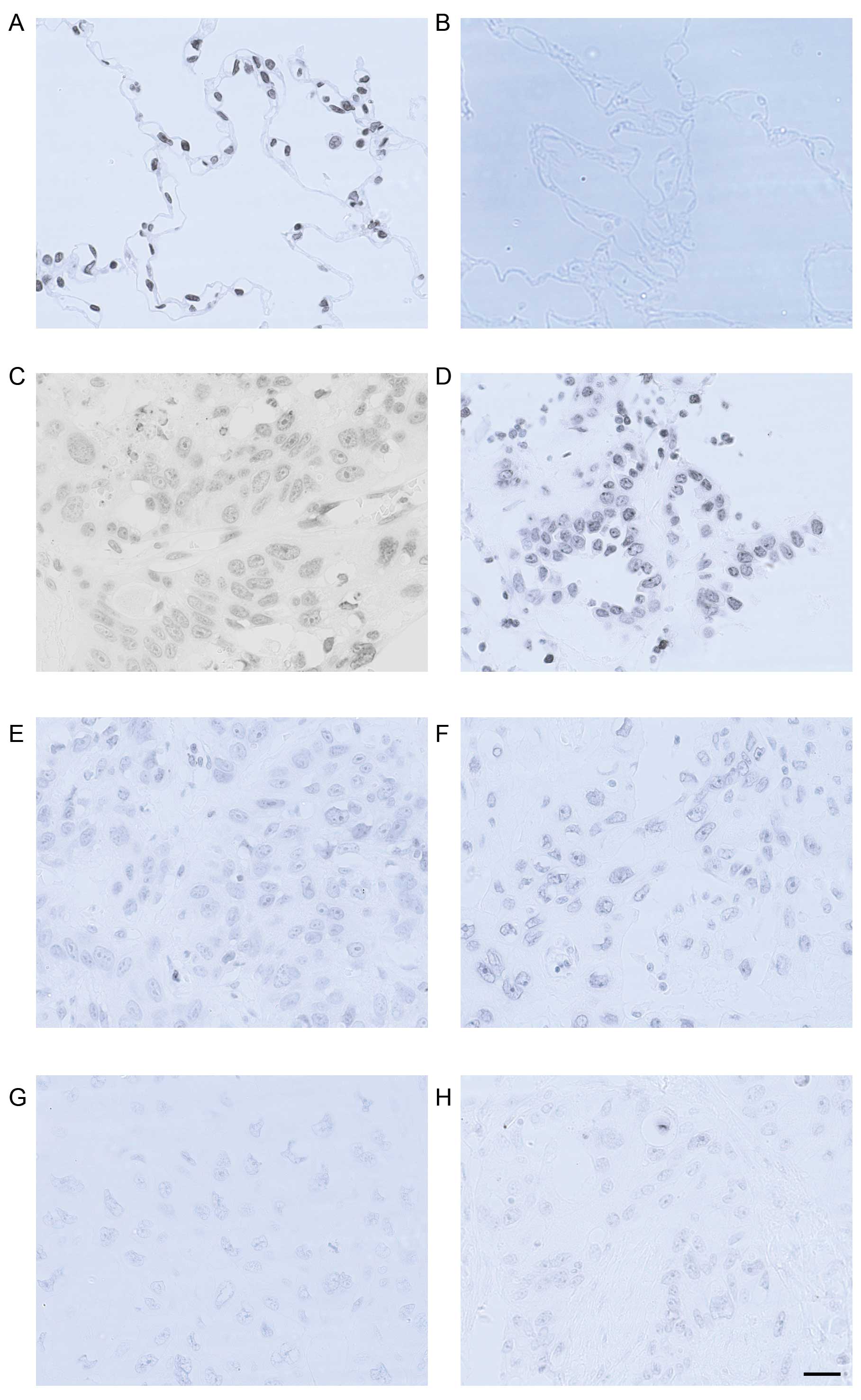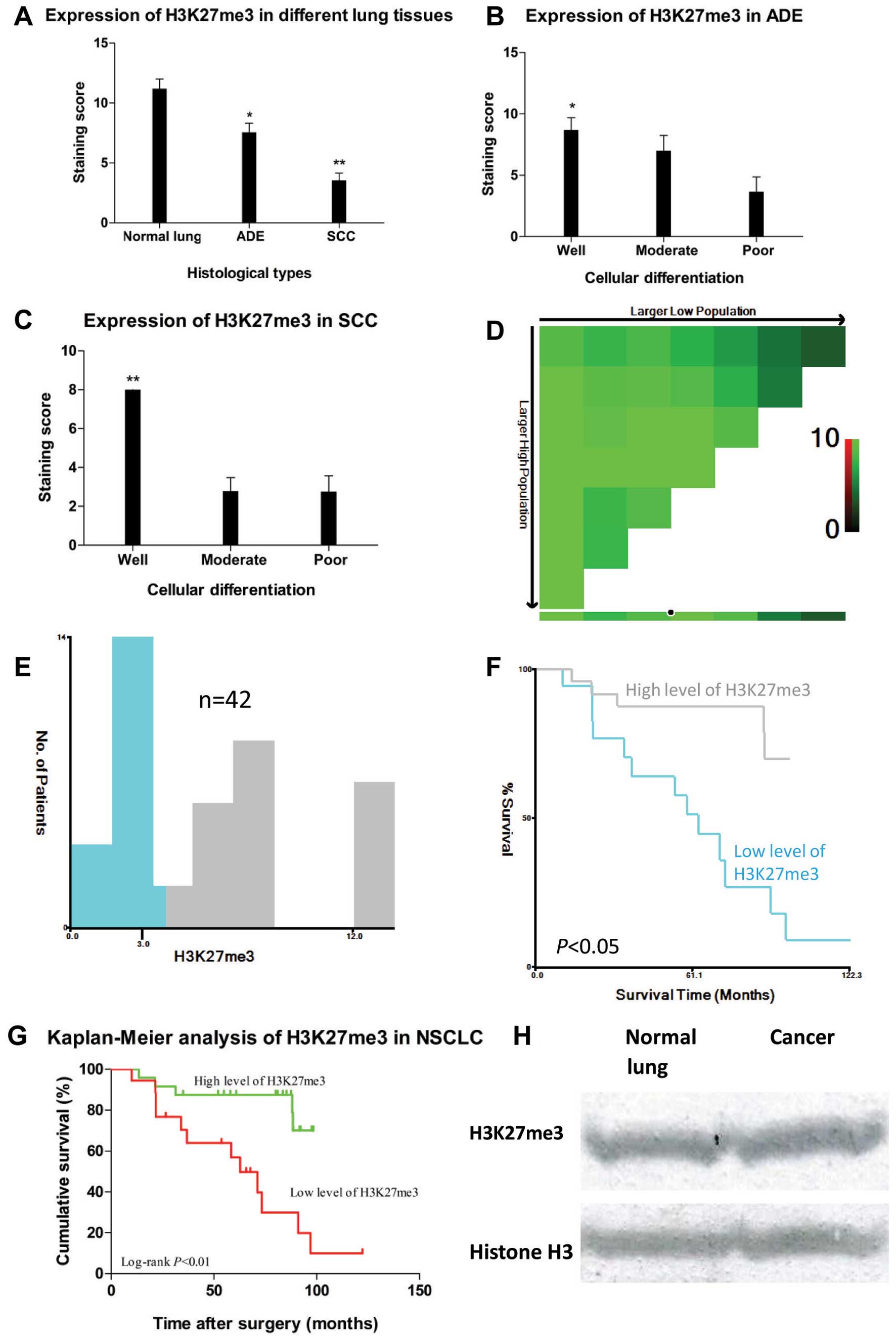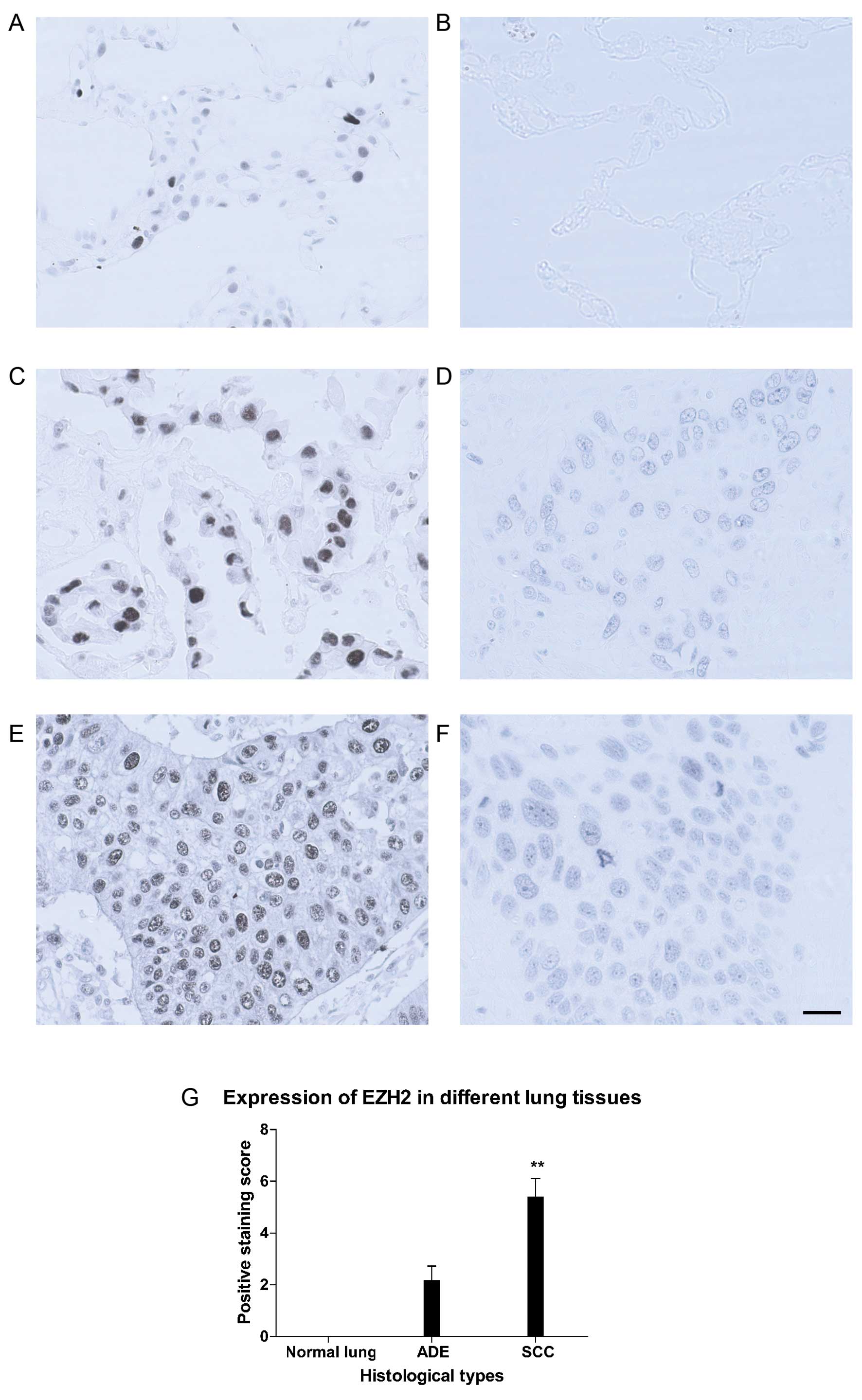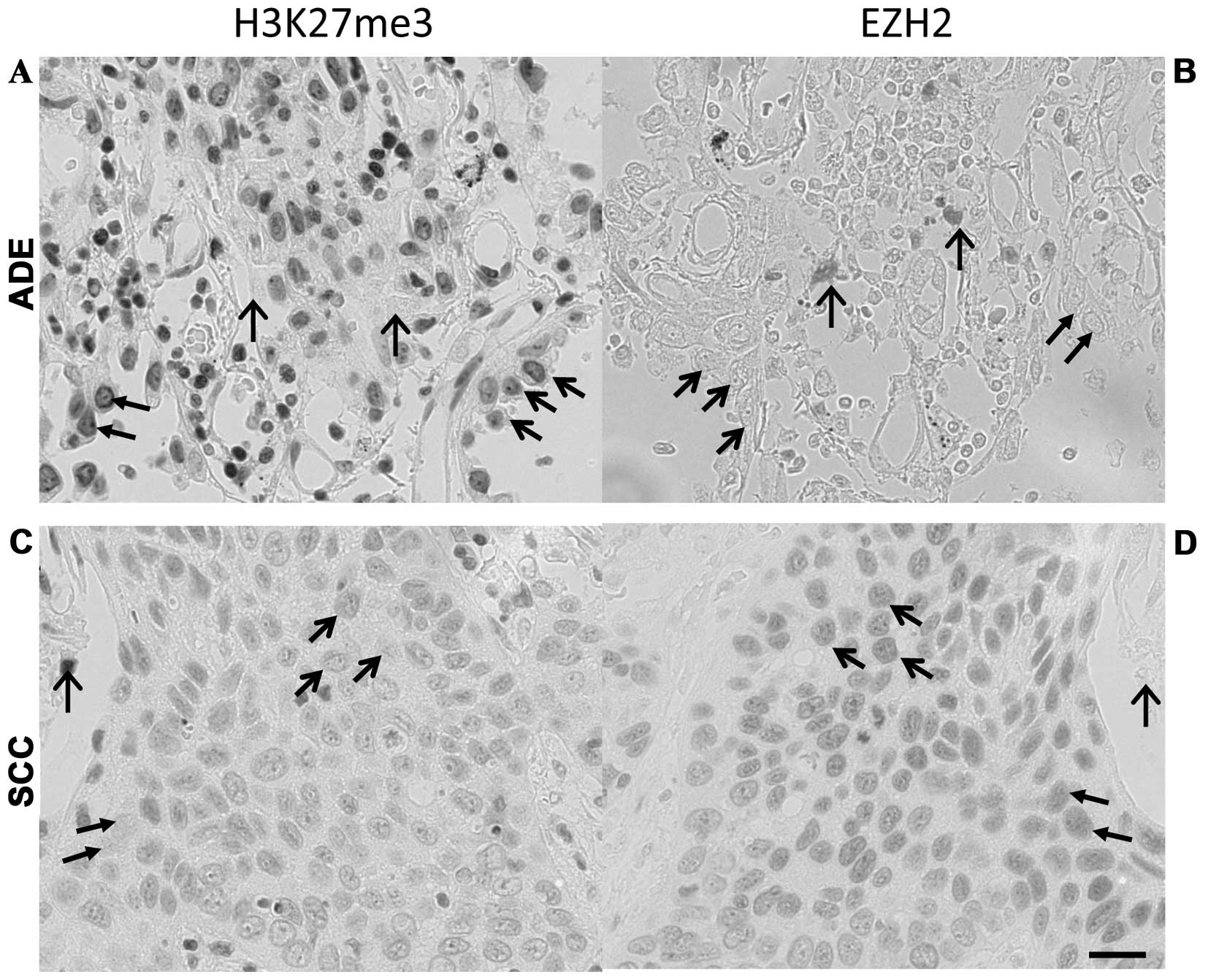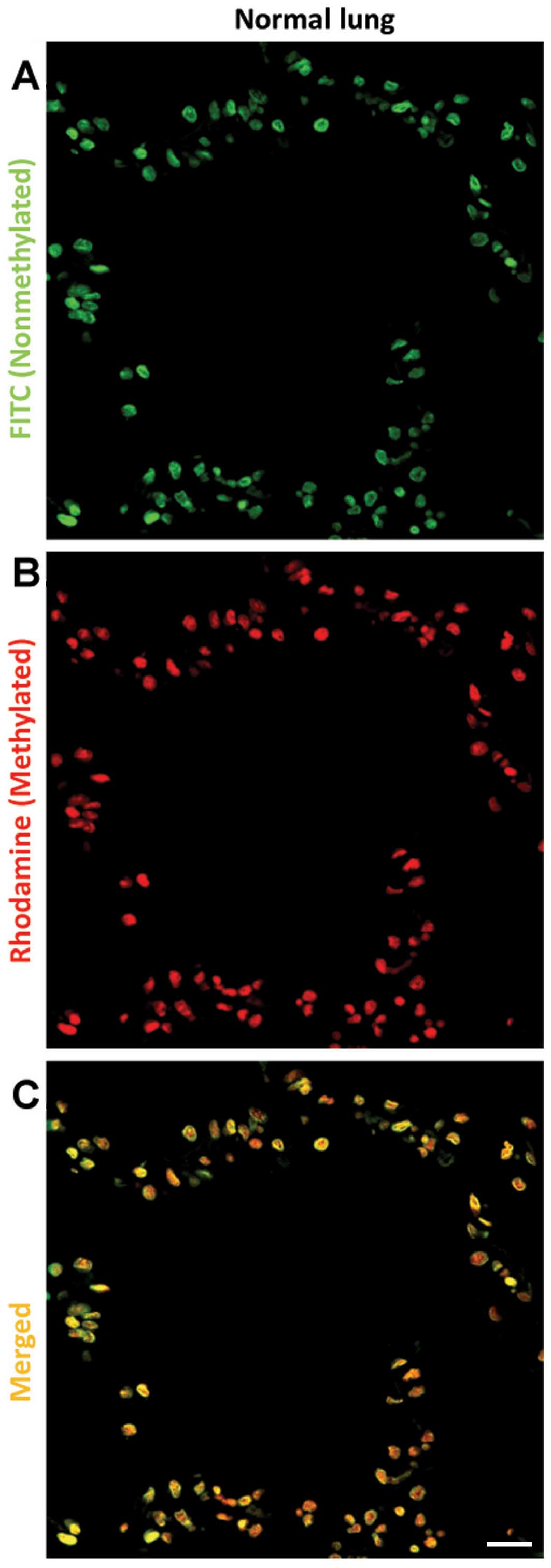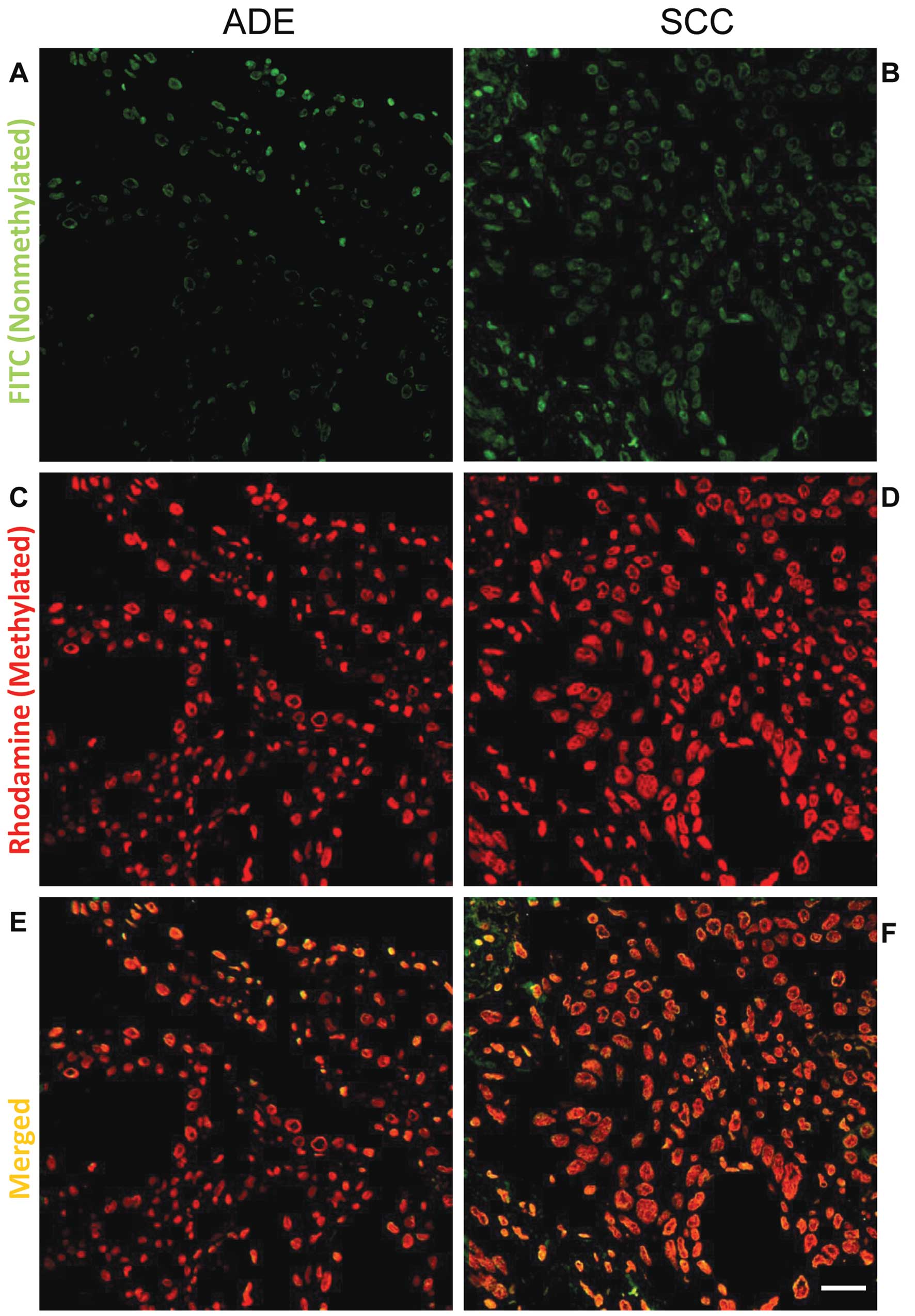High expression of trimethylated histone H3 at lysine 27 predicts better prognosis in non-small cell lung cancer
- Authors:
- Published online on: August 20, 2013 https://doi.org/10.3892/ijo.2013.2062
- Pages: 1467-1480
Abstract
Introduction
Lung cancer is still the leading cause of cancer death in both sexes throughout the world. More people die of lung cancer than of colon, breast, and prostate cancers combined, i.e., more than 1.2 million deaths each year (1). Non-small cell lung cancer (NSCLC) accounts for approximately 85–90% of all lung cancers. The poor prognosis of NSCLC is mainly due to late diagnosis, in as much as only 20 to 30% of patients are eligible for surgical resection. Despite the development of new chemotherapeutic drugs and multimodal treatment strategies, the survival rate of NSCLC remains unchanged and poor. Identification of new prognostic markers for the characterization of lung-cancer biology may be helpful, as they could serve as a basis for predicting response to radiation and chemotherapy at a molecular level.
The alterations in epigenomes such as DNA methylation and histone modifications play pivotal roles in carcinogenesis (2–4). It has been reported that DNA methylation level and global histone modification patterns may be possible predictors of cancer recurrence and prognosis in a large variety of cancer entities (5,6). Post-translational modification of histone tails alters the physical state of chromatin and has an essential role in both transcriptional repression and activation during embryonic development, lineage specification, terminal differentiation and tumorigenesis as well (7,8). One such repressive modification, the trimethylation of lysine 27 on histone H3 (H3K27me3), seemed to be an epigenetic label mediating gene silencing; and a mark for de novo DNA methylation in cancer cells by recruitment of DNA methyltransferase (DNMTs) (9–11), contributing to tumor progression through suppression of a certain gene expression (12). In fact, many recent studies have revealed that H3K27me3 may be involved in the characterization of various types of human cancers, including breast cancer (5,13), hepatocellular carcinoma (14), prostate cancer (15), Hodgekin’s lymphoma (16), esophageal cancer (17) and nasopharyngeal carcinoma (18). Reports of H3K27me3 levels in different cancer samples are somewhat contradictory. It is demonstrated that low H3K27me3 levels predicted poor outcome in breast, ovarian and pancreatic cancers (5) while high levels predicted poor outcome in hepatocellular carcinoma (14) and esophageal squamous cell carcinoma (17).
Moreover, H3K27 methylation is catalyzed by the SET domain of its specific methyltransferase, enhancer of zeste homolog 2 (EZH2), and requires the presence of 2 additional proteins, i.e., suppressor of zeste 12 (SUZ12) and embryonic ectoderm development (EED) (19). These proteins, together with the histone binding proteins retinoblastoma binding protein 4 (RBBP4) and RBBP7, comprise the core components of the polycomb repressive complex 2 (PRC2). Overexpression of EZH2 was also found in a variety of cancers, including lung cancer (20,21), breast cancer (5,22–26), melanoma (27), colorectal (20) and pancreatic adenocarcinoma (28) and ovarian carcinoma (29), and turned out to be closely associated with high proliferation rate and aggressive tumor subgroups, resulting in worse clinical outcome thereafter. Although many reports on the role of H3K27me3 in carcinogenesis are available, its carcinogenic role in NSCLC and how it interacts with EZH2 and DNA methylation remain unclear.
In the present study, we investigated the prognostic value of immunostaining for H3K27me3 and its relationship with EZH2 expression in NSCLC patients. We examined the correlation between these parameters and the level of DNA methylation at CCGG sites, detected by histo-endonuclease-linked detection of methylation sites of DNA (HELMET) (30). Since there had been several reports to indicate that H3K27me3 and EZH2 were involved in the early stage of various cancers, we focused on stage I NSCLCs in this study.
Materials and methods
Patients and tissue preparation
Five normal lung tissue and 42 NSCLC patients (22 adenocarcinomas and 20 squamous cell carcinomas) with early-stage (stage I) were included in our study. Patients underwent radical resection of primary tumor (lobectomy or pneumonectomy) and systematic lymph-adenectomy at the First Department of Surgery, Nagasaki University Hospital (Nagasaki, Japan), between 2000 and 2006. The patients’ clinicopathological data are shown in Table I. None of the patients had received chemo- or radiotherapy before tissue collection. The histopathologic features of the tumor specimens were classified in accordance with the WHO criteria. The TNM staging was determined according to the latest National Comprehensive Cancer Network (NCCN, Version 2, 2013) guidelines for NSCLC. The study protocol was approved by the Human Ethics Review Committee of Nagasaki University School of Medicine, and a signed informed consent was obtained from each patient. Each specimen was fixed overnight in 10% buffered formalin at room temperature (RT) and embedded in paraffin. Serial sections were cut at a thickness of 4 μm and placed onto 3-aminopropyltriethoxysilane-coated glass slides. Some sections were stained with hematoxylin and eosin in a routine manner for histological examination.
Chemicals and biochemicals
Bovine serum albumin (BSA) (essentially fatty acid and globulin-free), Trizma base, 2-mercaptoethanol, 3-aminopropyltriethoxysilane, Triton X-100, and Brij-35 were from Sigma Chemical Co. (St. Louis, MO, USA). Sodium dodecyl sulfate (SDS)-polyacrylamide gel electrophoresis (PAGE) reagents and the molecular marker set were purchased from Daiichi Pure Chemicals (Tokyo, Japan). Polyvinylidene fluoride membrane (PVDF) was purchased from Millipore (MA, USA). Lima bean trypsin inhibitor was purchased from Worthington Biochemical (Lakewood, NJ, USA); the protein assay kit and Coomassie Brilliant Blue were purchased from Bio-Rad Laboratories (Hercules, CA, USA); and 3,3′-diaminobenzi-dine-4HCl (DAB) was purchased from Dojin Chemical Co. (Kumamoto, Japan). Biotin-16-dUTP, digoxigenin-11-dUTP, Rhodamine anti-Dig and terminal deoxynucleotidyl transferase (TdT) were from Roche Diagnostics (Mannheim, Germany). Dideoxy ATP (ddATP) and dideoxy TTP (ddTTP) were from Jena Bioscience (Jena, Germany). HpaII and MspI were from Takara Bio Inc. (Shiga, Japan). 4′,6-diamidino-2-phenyl-indole, dihydrochloride (DAPI) was from Invitrogen Corporation (Carlsbad, CA, USA). Permount was from Fisher Scientific Inc. (Bridgewater, NJ, USA). All other reagents used in this study were from Wako Pure Chemicals (Osaka, Japan) and were of analytical grade.
Immunohistochemistry for H3K27me3, EZH2, PCNA and simultaneous localization of EZH2 and PCNA
Immunohistochemistry was performed with the indirect enzyme-labeled antibody method, as described previously (31–33). Antibodies used in IHC are listed in Table II. For detection of H3K27me3, EZH2 and PCNA, paraffin-embedded sections were deparaffinized with toluene and rehydrated in graded alcohols. After autoclaved for 15 min at 120°C in 10 mM citrate buffer (pH 6.0) for antigen retrieval, endogenous peroxidase was inactivated with 0.3% hydrogen peroxide in methanol for 15 min. The sections were then pre-incubated with 500 μg/ml normal goat IgG dissolved in 1% BSA in PBS (pH 7.4) for 1 h, reacted with primary antibodies for 16 h, washed with 0.075% Brij 35 in PBS, and then incubated with HRP-conjugated goat anti-rabbit IgG (H3K27me3/EZH2) or HRP-conjugated goat anti-mouse IgG (PCNA) in 1% BSA in PBS for 1 h. After washing with 0.075% Brij 35 in PBS, the sites of HRP were visualized with DAB and H2O2 in the presence of nickel and cobalt ions (34). As a negative control, some sections were reacted with normal rabbit IgG or normal mouse IgG instead of the specific antibodies. For simultaneous staining of EZH2 and PCNA, the sections were incubated with Alexa 546 anti-rabbit IgG and Alexa 488 anti-mouse IgG (both 1:500) in darkness for 1 h, then washed with 0.075% Brij 35 in PBS in darkness and finally observed with 0.5 μg/ml DAPI for 1 min. The stained slides were analyzed under a laser scanning microscope (LSM 5 PASCAL; Carl Zeiss Inc., Germany).
Quantitative evaluation
Staining results were examined by two observers masked to patients’ clinical information. Another reading by a third observer was needed to reach a consensus when there was a significant discrepancy between initial readings. At least 5 high-power fields and more than 2,000 cells were calculated in each case with a light microscope (Zeiss 2021-85; Carl Zeiss Inc.) at ×400 magnification. Immunostaining results were evaluated by using a semi-quantitative scoring system according to the method described in the study by Ellinger et al (15). That is, the number of positive cancerous cells was estimated as follows (0, no positive cells; 1, 0> and ≤25% positive cells; 2, >25 and ≤50% positive cells; 3, >50 and ≤75% positive cells; and 4, >75 and ≤100% positive cells). These scores were multiplied with an intensity scale (0, negative; 1, weak; 2, moderate; and 3, intensive), and the final score ranged from 0–12.
Western blot analysis of H3K27me3
Western blot analysis was carried out as detailed previously (35). In brief, human lung cancer specimens and normal lung tissue were homogenized, and the lysates were centrifuged. Soluble proteins were separated on 10% SDS-PAGE gel (Daiichi Pure Chemical, Tokyo, Japan) with equal amounts (10 μg) of protein per lane. Separated proteins were electrophoretically transferred onto polyvinylidene difluoride (PVDF) membranes (Millipore), blocked with 10% non-fat milk in TBS (20 mM Tris buffer, pH 7.6, and 150 mM NaCl) for 1 h and then incubated overnight at 4°C with rabbit polyclonal anti-H3 (Cell Signaling Technology, MA, USA) and H3K27me3 antibody. As a secondary antibody, HRP-goat anti-rabbit IgG was reacted for 1 h and then the bands were visualized with DAB, Ni, Co and H2O2.
In situ evaluation of DNA methylation
To evaluate the DNA methylation level of pathological slides of NSCLC at CCGG sites, histo-endonuclease-linked detection of methylation sites of DNA (HELMET) was performed (30). Paraffin sections were dewaxed and digested with 10 μg/ml of proteinase K in PBS at 37°C for 15 min. Then the sections were incubated with TdT buffer (25 mM Tris-HCl buffer, pH 6.6, containing 0.2 M potassium cacodylate and 0.25 mg/ml BSA) alone at RT for 30 min. After incubation, the slides were reacted with 800 U/ml of TdT dissolved in TdT buffer containing 20 μM ddATP, 20 μM ddTTP, 1.5 mM CoCl2 and 0.1 mM dithiothreitol at 37°C for 2 h. After washing with PBS, the sections were fixed with freshly-prepared 4% PFA in PBS for 5 min and then rinsed with PBS. The non-methylated CCGG sites were digested at 37°C for 2 h by 100 U/ml HpaII dissolved in 10 mM Tris-HCl buffer (pH 7.5), containing 10 mM MgCl2 and 1 mM dithiothreitol. The HpaII-cut sites were labeled with biotin-16-dUTP by TdT reaction for 90 min. Then, the 3′-OH ends were blocked with a mixture of dideoxynucleotides by TdT, as described above, for 2 h. After fixation with 4% PFA in PBS, the methylated CCGG sites were digested at 37°C for 2 h by 100 U/ml MspI dissolved in Tris-HCl buffer (pH 7.9), containing 10 mM MgCl2, 0.5 mM dithiothreitol, 66 mM potassium acetate, and 0.1% BSA. The MspI-cut sites were then labeled with digoxigenin-11-dUTP by TdT reaction for 90 min. Finally, the sections were incubated with a mixture of 500 μg/ml normal goat IgG and normal sheep IgG in 5% BSA/PBS for 1 h, and then visualized by FITC-labeled goat anti-biotin and rhodamine-labeled sheep anti-digoxigenin. The nuclei were stained with 0.5 μg/ml DAPI for 1 min.
Statistical analysis
The X-tile software program (Version 3.6.1; Yale University School of Medicine, New Haven, CT, USA) as described previously (36) was used to determine the best threshold value of H3K27me3 for classifying samples into groups of high and low expression. The SPSS 18.0 statistical software package (SPSS Inc, Chicago, IL, USA) was employed for all analyses. The association between tested markers and different clinicopathological characteristics of the patients, including age, gender, tissue type, tumor differentiation, P-factor, LV-factor, V-factor, smoking status, relapse, postoperative metastasis and CEA level were evaluated by Pearson’s χ2 or Fisher’s exact test as appropriate. The Kaplan-Meier method with log-rank test was used for estimating probability of overall survival. The Cox proportional hazard model was used to evaluate the association between various markers and patient’s survival. Univariate and multivariate analyses were determined by Cox regression. A p-value <0.05 was considered statistically significant.
Results
Clinicopathological data of patients
As shown in Table I, the diagnosis of the 5 normal lung specimens was identically pneumothorax. Three females and 2 males were included, with an average age of 67.6 years. The cancer patient population included 27 males and 15 females and had a mean age of 69 years. By histological classification, 20 cases were squamous cell carcinoma and 22 were adenocarcinoma. Of the 22 cases of adenocarcinoma, 13 patients had well-differentiated tumor, 6 had moderately- and 3 had poorly-differentiated tumor. In the 20 cases of squamous cell carcinoma, the well-, moderately- and poorly-differentiated numbers were 3, 9 and 8, respectively. All cases were TNM stage I and lymph node negative. Postoperative follow-up data were available in all cases, and the median follow-up duration in adenocarcinoma and squamous cell carcinoma groups were 75.2 months and 52.9 months, respectively.
Trimethylation level of histone H3 at lysine 27 in normal lung and NSCLC tissues
Either in normal lung or NSCLC tissues, H3K27me3 was localized predominantly in the nuclei (Fig. 1). Specificity of the antibody for H3K27me3 was determined by western blot analysis (Fig. 2H). Calculated staining score of immunopositive cells ranged from 0 to 12 in all tested tissues. According to the X-tile plots (Fig. 2D–F), we categorized the samples into low (IHC score ≤3) and high (IHC score >3) expression subgroups based on a cut-point determined by X-tile software related to survival status ((Fig. 2F, P<0.05). As shown in Fig. 2A, high expression of H3K27me3 was observed in all 5 (100%) normal lung tissues, whereas in cancer tissues, high methylation level of H3K27 was found in 18 (81.8%) adenocarcinomas and 6 (30%) squamous cell carcinomas (P<0.01). The staining score of H3K27me3 was significantly higher in normal lung tissue compared to those of adenocarcinoma and squamous cell carcinoma (11.2±0.8, 7.55±0.77 and 3.55±0.61, respectively, P<0.05, Figs. 1 and 2A). In addition, a positive relationship between tumor differentiation and H3K27me3 expression was found (Figs. 1, 2B and C). In both cancer subtypes, higher positive staining score was correlated with better cellular differentiation (P<0.01). In the adenocarcinoma subgroup, staining scores for well-, moderately- and poorly-differentiated NSCLC samples were 8.69±1.00, 7.00±1.24 and 3.67±1.20, respectively (P<0.01). In the squamous cell carcinoma subgroup, their staining scores were 8.00, 2.78±0.70 and 2.75±0.82, respectively (P<0.01).
Correlation of H3K27me3 expression with clinicopathological parameters
To determine the correlation of H3K27me3 expression and clinicopathological parameters, and to determine its prognostic impact, χ2 analyses together with univariate, multivariate and Kaplan-Meier survival analyses of cumulative survival analysis were performed. Correlation analyses (Table III) revealed that H3K27me3 expression was significantly associated with non-SCC histology (P= 0.001), better cellular differentiation (P=0.002), non-smoking status (P= 0.019), low EZH2 expression (P= 0.038), high methylation level at CCGG sites (P= 0.049) and tumor-specific survival after resection of primary tumors (P<0.01 by log-rank test, Fig. 2G). Kaplan-Meier survival analysis revealed that patients with higher H3K27me3 expression in tumors showed longer disease-free survival in contrast to those with low expression. Univariate analysis revealed associations between poor prognosis in NSCLC patients and several factors, including low H3K27me3 expression (P= 0.002), histologic type (non-ADE, P= 0.011), smoking status (smoker, P= 0.002), relapse (P<0.01), and postoperative metastasis (P<0.01, Table IV). Using a Cox proportional hazard regression analysis, we found that expression of H3K27me together with postoperative metastasis were independent predictors associated with prognostic outcome (Table IV).
Table III.Association of H3K27me3, EZH2 expression and DNA methylation level at CCGG sites with clinicopathologic parameters in NSCLC patients. |
Expression of EZH2 in lung tissues and its correlation with clinicopathological parameters
As shown in Fig. 3 (right panel), EZH2 was localized predominantly in nuclei, although occasionally it could be seen in the cytoplasm as background. In contrast with H3K27me3, no EZH2 staining was found in any of the 5 normal lung samples, and the staining for EZH2 in SCC was generally more intense than that of ADE (5.40±0.71 vs. 2.18±0.54, P<0.01, Fig. 3B, D, F and G). Of 22 adenocarcinomas, 3 cases (13.6%) were defined as high expression. While in squamous cell carcinoma group, 15 out of 20 cases (75%) were considered as high expression (Fig. 3G). χ2 analyses demonstrated that when related to clinicopathological data (Table III), expression of EZH2 in NSCLC patients was found to be significantly associated with male gender (P= 0.026), non-ADE histology (P<0.01), smoking status (P=0.019), low H3K27me3 expression (P=0.038), invasion into veins (V-factor, P=0.038), low methylation level at CCGG sites (P=0.049) and high PCNA percentage (P= 0.029). It should be noted that the expression of EZH2 was correlated with lower level of H3K27 methylation while with enhanced PCNA expression, indicating its positive correlation with cell proliferating activity (Table III, Figs. 3A–F and 4). The reciprocal expression pattern of EZH2 and H3K27me3 in NSCLC was also confirmed immunohistochemically in mirror sections. As shown in Fig. 5, in lung adenocarcinoma (upper panel), the cells heavily stained for H3K27me3 were essentially negative or weak for EZH2 staining. In lung squamous cell carcinoma (lower panel), the expression of H3K27me3 seemed generally weaker than that of adenocarcinoma, however, identical cells with negative or weak staining of H3K27me3 were found with high level expression of EZH2. Both correlation analysis (Table III) and immunofluorescence double staining for EZH2 and PCNA (Fig. 4) confirmed that PCNA index was positively correlated with EZH2 expression. In contrast, neither univariate nor multivariate analysis indicated that EZH2 was an independent prognostic factor for surgically treated NSCLC patients enrolled in this study (P=0.720).
DNA methylation level at CCGG sites and its relation with clinicopathological parameters
As shown in Figs. 6 and 7, CCGG sites in cancer cells were generally hypermethylated, compared to that of normal cells. Although no correlation was found between DNA methylation level at CCGG sites and DFS/OS, we found that higher DNA methylation level at CCGG sites in NSCLC patients was significantly associated with less pulmonary vein invasion (V-factor, P= 0.049), non-smoking status (P= 0.016), low EZH2 expression (P= 0.049) and high H3K27me3 expression (P= 0.049) (Table III). Although the expression of H3K27me3 was correlated with differentiation status, and DNA methylation level at CCGG sites was correlated with the methylation level of H3K27 positively, no correlation between DNA methylation and differentiation level was found (P= 0.261).
Discussion
In the present study, we investigated the prognostic value of H3K27me3 and EZH2 expression in human lung cancer immunohistochemically, and found that, in comparison to normal lung tissue, the level of H3K27me3 was significantly downregulated in both ADE and SCC tissues of early-staged NSCLC. Furthermore, in each cancer subtype, the level of H3K27me3 was antiparallel with the cellular differentiation level, and the decrease in H3K27me3 was significantly correlated with tumor relapse and shorter overall survival, strongly demonstrating that the level of H3K27me3 is a new epigenetic marker in lung cancers. In contrast, although EZH2 is known to catalyze trimethylation of H3K27, the expression of EZH2 in it was not significantly correlated with lung carcinogenesis.
With regard to the prognostic impact of H3K27me3 in various human cancers, it was reported that overexpression of H3K27me3 was linked to more malignant behavior and worse prognosis in patients with prostate (15), esophageal (17), nasopharyngeal (18) and hepatocellular carcinomas (14). On the other hand, in breast, ovarian and pancreatic cancers (5) and renal cell carcinoma (37), reduced expression of H3K27me3 was associated with worse prognosis. In human NSCLCs, however, we have found that a lower level of H3K27me3 was associated with higher tumor invasiveness and/or poorer disease-free survival (DFS) in this study. These contradictory findings may in part reflect that H3K27me3 marks different genes for silencing in different cell types. In the present study, we observed that low expression of H3K27me3 was a strong and independent predictor of poor cellular differentiation and shortened cancer-specific survival, as evidenced by univariate and multivariate analyses (Table IV). When the Cox regression model was constructed for the entire series, low H3K27me3 expression remained an independent predictive factor of recurrence and/or cancer death in NSCLC patients. To our knowledge, our data presented here demonstrated for the first time a direct association of expression of H3K27me3 with clinical outcome with NSCLCs. As H3K27me3 serves as an epigenetic mark mediating silencing and represses target gene expression, loss of it may result in reactivation of these silenced genes, such as some oncogenes, and therefore contributing to tumorigenesis or cancer progression.
EZH2 is involved in PRC2-directed gene silencing through the formation of H3K27me3 as an epigenetic marker. It was reported that EZH2 was found to be overexpressed at both mRNA and protein levels in NSCLC and bladder cancer, and correlated with invasiveness, increased proliferation and poor outcome (20,21). In colorectal cancer, EZH2 overexpression indicated a good prognosis, in contrast to the poor prognosis associated with EZH2 overexpression in NSCLCs (20). In the current study, we found that the higher expression of EZH2 in NSCLC patients was significantly associated with various clinicopathological parameters including PCNA labeling index, which was consistent with the findings of Takawa et al (20), while we failed to confirm the significant correlation with poor prognosis (P=0.154). Further study with a greater number of specimens is needed.
In addition, we found that the expression of H3K27me3 was reversely correlated with that of EZH2 in NSCLC (Table III and Fig. 5). Similar findings have been recently reported by Holm et al (38) in breast cancer. Previous studies indicated that the polycomb group protein EZH2 directly methylated DNA in either normal (39) or cancerous (11) tissues, and might result in the inhibition of target gene expression through its methylation, also overexpression of EZH2 promoted formation of a different PRC complex, the PRC4, and exhibited differential histone substrate specificities (40). Loss of H3K27me3 in tumor might reflect the formation of the new PRC complex to modify other histone residues. Since EZH2 methyltransferase activity requires its association with other PRC components, it has been proposed that overexpression of EZH2 may result in the disruption of the integrity of the PRC complexes or may form new PRC complexes (41,42), and thus the methyltransferase activity toward H3K27 may be changed.
It is clear that histone methylation marks do not act alone, but in a coordinated manner with other epigenetic modifications (4). DNA methylation principally occurs at cytosine residues located in dinucleotide CpG sites (43). CpG dinucleotides are statistically under-represented in the genome but are found to be concentrated in CG-rich regions termed CpG islands that frequently coincide with promoter or gene regulatory regions (3). Global hypomethylation appears to be an early event for colon and breast cancer as well as chronic lymphacytic leukemia (CLL) (44). In the present study, we evaluated the DNA methylation level at CCGG sites by means of HELMET, indicating that cancerous tissues were relatively hypermethylated in DNA at CCGG sites in contrast to that of normal lung tissue. This result is consistent with previous finding, that gene hypermethylation is an early event in the process of tumorigenesis of lung cancer (45). We also found that higher DNA methylation level at CCGG sites were statistically correlated with less chance of venous invasion, non-smoking status, lower expression of EZH2 and higher expression of H3K27me3 as well, although no significance of correlation with overall survival was found. This finding might still suggest that hypermethylation at CCGG sites contributes to better prognosis in NSCLC patients, because those factors were more or less affecting the outcome of NSCLC patients. On the other hand, Lin et al (46) have reported that hypermethylation in CpG was correlated with poor prognosis in NSCLC, contrary to our findings. Although the reason for this discrepancy is not known, the genes that were hypermethylated in the studies might be different. Since DNA methylation in cancer was mainly targeted to polycomb-regulated genes and a very high percentage of the methylated genes was pre-marked with trimethylated H3K27 in addition to other polycomb components (10), further study is needed to clarify which gene is involved and whether or not methylation of H3K27 also plays a role in the interaction with this hypermethylation.
Some limitations of this research should be noted. First of all, the dataset was small and as a result the statistical power would be somewhat limited. Further study with larger number of samples is necessary to validate the present results. Although the number of specimens used here was limited, we did achieve some significant indications, showing that high expression of H3K27me3 was correlated with longer disease-free survival. Secondly, all the cases involved in this study were patients of TNM stage I. Although chemotherapy or radiotherapy would be used after progression had been proved, the contribution of other therapies to overall survival had not been taken into account in the survival analysis, for surgery was considered the key therapy for patients at this stage, and thus would probably lead to some bias.
In conclusion, our study indicated that high expression of H3K27me3 was associated with clinicopathological parameters and correlated with better outcome in NSCLC patients as well. Thus H3K27me3 can be used as a good marker, enabling us to predict the prognosis of NSCLC patients, and to carry out a more intensive follow-up according to H3K27me3 expression status in resected specimens.
Abbreviations:
|
NSCLC |
non-small cell lung cancer; |
|
H3K27me3 |
trimethylated histone H3 at lysine 27; |
|
EZH2 |
enhancer of zeste homolog 2; |
|
PCNA |
proliferating cell nuclear antigen; |
|
OS |
overall survival; |
|
DNMTs |
DNA methyltransferase; |
|
SUZ12 |
suppressor of zeste 12; |
|
EED |
embryonic ectoderm development; |
|
RBBP |
retinoblastoma binding protein; |
|
PRC2 |
polycomb repressive complex 2; |
|
HELMET |
histo endonuclease-linked detection of methylation sites of DNA |
Acknowledgements
This study was supported in part by a Grant-in-Aid for Scientific Research from the Japan Society for the Promotion of Science (no. 18390060 to T.K.).
References
|
Jemal A, Bray F, Center MM, Ferlay J, Ward E and Forman D: Global cancer statistics. CA Cancer J Clin. 61:69–90. 2011. View Article : Google Scholar | |
|
Lund AH and van Lohuizen M: Epigenetics and cancer. Genes Dev. 18:2315–2335. 2004. View Article : Google Scholar : PubMed/NCBI | |
|
Taniguchi H, Yamamoto H, Akutsu N, et al: Transcriptional silencing of hedgehog-interacting protein by CpG hypermethylation and chromatic structure in human gastrointestinal cancer. J Pathol. 213:131–139. 2007. View Article : Google Scholar | |
|
Zhang C, Li H, Zhou G, et al: Transcriptional silencing of the TMS1/ASC tumour suppressor gene by an epigenetic mechanism in hepatocellular carcinoma cells. J Pathol. 212:134–142. 2007. View Article : Google Scholar : PubMed/NCBI | |
|
Wei Y, Xia W, Zhang Z, et al: Loss of trimethylation at lysine 27 of histone H3 is a predictor of poor outcome in breast, ovarian, and pancreatic cancers. Mol Carcinog. 47:701–706. 2008. View Article : Google Scholar : PubMed/NCBI | |
|
Mitani Y, Oue N, Hamai Y, et al: Histone H3 acetylation is associated with reduced p21(WAF1/CIP1) expression by gastric carcinoma. J Pathol. 205:65–73. 2005. View Article : Google Scholar : PubMed/NCBI | |
|
Kouzarides T: Chromatin modifications and their function. Cell. 128:693–705. 2007. View Article : Google Scholar : PubMed/NCBI | |
|
Prystowsky MB, Adomako A, Smith RV, et al: The histone deacetylase inhibitor LBH589 inhibits expression of mitotic genes causing G2/M arrest and cell death in head and neck squamous cell carcinoma cell lines. J Pathol. 218:467–477. 2009. View Article : Google Scholar | |
|
Ohm JE, McGarvey KM, Yu X, et al: A stem cell-like chromatin pattern may predispose tumor suppressor genes to DNA hypermethylation and heritable silencing. Nat Genet. 39:237–242. 2007. View Article : Google Scholar : PubMed/NCBI | |
|
Schlesinger Y, Straussman R, Keshet I, et al: Polycomb-mediated methylation on Lys27 of histone H3 pre-marks genes for de novo methylation in cancer. Nat Genet. 39:232–236. 2007. View Article : Google Scholar : PubMed/NCBI | |
|
Vire E, Brenner C, Deplus R, et al: The Polycomb group protein EZH2 directly controls DNA methylation. Nature. 439:871–874. 2006. View Article : Google Scholar : PubMed/NCBI | |
|
Karlic R, Chung HR, Lasserre J, Vlahovicek K and Vingron M: Histone modification levels are predictive for gene expression. Proc Natl Acad Sci USA. 107:2926–2931. 2010. View Article : Google Scholar : PubMed/NCBI | |
|
Yoo KH and Hennighausen L: EZH2 methyltransferase and H3K27 methylation in breast cancer. Int J Biol Sci. 8:59–65. 2012. View Article : Google Scholar : PubMed/NCBI | |
|
Cai MY, Hou JH, Rao HL, et al: High expression of H3K27me3 in human hepatocellular carcinomas correlates closely with vascular invasion and predicts worse prognosis in patients. Mol Med. 17:12–20. 2011. | |
|
Ellinger J, Kahl P, von der Gathen J, et al: Global histone H3K27 methylation levels are different in localized and metastatic prostate cancer. Cancer Invest. 30:92–97. 2012. View Article : Google Scholar : PubMed/NCBI | |
|
Anderton JA, Bose S, Vockerodt M, et al: The H3K27me3 demethylase, KDM6B, is induced by Epstein-Barr virus and over-expressed in Hodgkin’s lymphoma. Oncogene. 30:2037–2043. 2011.PubMed/NCBI | |
|
Tzao C, Tung HJ, Jin JS, et al: Prognostic significance of global histone modifications in resected squamous cell carcinoma of the esophagus. Mod Pathol. 22:252–260. 2009. View Article : Google Scholar : PubMed/NCBI | |
|
Cai MY, Tong ZT, Zhu W, et al: H3K27me3 protein is a promising predictive biomarker of patients’ survival and chemoradioresistance in human nasopharyngeal carcinoma. Mol Med. 17:1137–1145. 2011.PubMed/NCBI | |
|
Chase A and Cross NC: Aberrations of EZH2 in cancer. Clin Cancer Res. 17:2613–2618. 2011. View Article : Google Scholar : PubMed/NCBI | |
|
Takawa M, Masuda K, Kunizaki M, et al: Validation of the histone methyltransferase EZH2 as a therapeutic target for various types of human cancer and as a prognostic marker. Cancer Sci. 102:1298–1305. 2011. View Article : Google Scholar : PubMed/NCBI | |
|
Huqun, Ishikawa R, Zhang J, et al: Enhancer of zeste homolog 2 is a novel prognostic biomarker in nonsmall cell lung cancer. Cancer. 118:1599–1606. 2012. View Article : Google Scholar : PubMed/NCBI | |
|
Gong Y, Huo L, Liu P, et al: Polycomb group protein EZH2 is frequently expressed in inflammatory breast cancer and is predictive of worse clinical outcome. Cancer. 117:5476–5484. 2011. View Article : Google Scholar : PubMed/NCBI | |
|
Kleer CG, Cao Q, Varambally S, et al: EZH2 is a marker of aggressive breast cancer and promotes neoplastic transformation of breast epithelial cells. Proc Natl Acad Sci USA. 100:11606–11611. 2003. View Article : Google Scholar : PubMed/NCBI | |
|
Chang CJ, Yang JY, Xia W, et al: EZH2 promotes expansion of breast tumor initiating cells through activation of RAF1-beta-catenin signaling. Cancer Cell. 19:86–100. 2011. View Article : Google Scholar : PubMed/NCBI | |
|
Kunju LP, Cookingham C, Toy KA, Chen W, Sabel MS and Kleer CG: EZH2 and ALDH-1 mark breast epithelium at risk for breast cancer development. Mod Pathol. 24:786–793. 2011. View Article : Google Scholar : PubMed/NCBI | |
|
Alford SH, Toy K, Merajver SD and Kleer CG: Increased risk for distant metastasis in patients with familial early-stage breast cancer and high EZH2 expression. Breast Cancer Res Treat. 132:429–437. 2012. View Article : Google Scholar : PubMed/NCBI | |
|
Bachmann IM, Halvorsen OJ, Collett K, et al: EZH2 expression is associated with high proliferation rate and aggressive tumor subgroups in cutaneous melanoma and cancers of the endometrium, prostate, and breast. J Clin Oncol. 24:268–273. 2006. View Article : Google Scholar : PubMed/NCBI | |
|
Fujii S, Fukamachi K, Tsuda H, Ito K, Ito Y and Ochiai A: RAS oncogenic signal upregulates EZH2 in pancreatic cancer. Biochem Biophys Res Commun. 417:1074–1079. 2012. View Article : Google Scholar : PubMed/NCBI | |
|
Guo J, Cai J, Yu L, Tang H, Chen C and Wang Z: EZH2 regulates expression of p57 and contributes to progression of ovarian cancer in vitro and in vivo. Cancer Sci. 102:530–539. 2011. View Article : Google Scholar : PubMed/NCBI | |
|
Koji T, Kondo S, Hishikawa Y, An S and Sato Y: In situ detection of methylated DNA by histo endonuclease-linked detection of methylated DNA sites: a new principle of analysis of DNA methylation. Histochem Cell Biol. 130:917–925. 2008. View Article : Google Scholar : PubMed/NCBI | |
|
An S, Hishikawa Y and Koji T: Induction of cell death in rat small intestine by ischemia reperfusion: differential roles of Fas/Fas ligand and Bcl-2/Bax systems depending upon cell types. Histochem Cell Biol. 123:249–261. 2005. View Article : Google Scholar : PubMed/NCBI | |
|
Shirendeb U, Hishikawa Y, Moriyama S, et al: Human papillomavirus infection and its possible correlation with p63 expression in cervical cancer in Japan, Mongolia, and Myanmar. Acta Histochem Cytochem. 42:181–190. 2009. View Article : Google Scholar : PubMed/NCBI | |
|
Song N, Liu J, An S, Nishino T, Hishikawa Y and Koji T: Immunohistochemical analysis of histone H3 modifications in germ cells during mouse spermatogenesis. Acta Histochem Cytochem. 44:183–190. 2011. View Article : Google Scholar : PubMed/NCBI | |
|
Adams JC: Heavy metal intensification of DAB-based HRP reaction product. J Histochem Cytochem. 29:7751981. View Article : Google Scholar : PubMed/NCBI | |
|
Yamayoshi T, Nagayasu T, Matsumoto K, Abo T, Hishikawa Y and Koji T: Expression of keratinocyte growth factor/fibroblast growth factor-7 and its receptor in human lung cancer: correlation with tumour proliferative activity and patient prognosis. J Pathol. 204:110–118. 2004. View Article : Google Scholar | |
|
Camp RL, Dolled-Filhart M and Rimm DL: X-tile: a new bioinformatics tool for biomarker assessment and outcome-based cut-point optimization. Clin Cancer Res. 10:7252–7259. 2004. View Article : Google Scholar : PubMed/NCBI | |
|
Rogenhofer S, Kahl P, Mertens C, et al: Global histone H3 lysine 27 (H3K27) methylation levels and their prognostic relevance in renal cell carcinoma. BJU Int. 109:459–465. 2012. View Article : Google Scholar : PubMed/NCBI | |
|
Holm K, Grabau D, Lovgren K, et al: Global H3K27 trimethylation and EZH2 abundance in breast tumor subtypes. Mol Oncol. 6:494–506. 2012. View Article : Google Scholar : PubMed/NCBI | |
|
Chen H, Tu SW and Hsieh JT: Down-regulation of human DAB2IP gene expression mediated by polycomb Ezh2 complex and histone deacetylase in prostate cancer. J Biol Chem. 280:22437–22444. 2005. View Article : Google Scholar : PubMed/NCBI | |
|
Kuzmichev A, Margueron R, Vaquero A, et al: Composition and histone substrates of polycomb repressive group complexes change during cellular differentiation. Proc Natl Acad Sci USA. 102:1859–1864. 2005. View Article : Google Scholar | |
|
Cao R and Zhang Y: The functions of E(Z)/EZH2-mediated methylation of lysine 27 in histone H3. Curr Opin Genet Dev. 14:155–164. 2004. View Article : Google Scholar : PubMed/NCBI | |
|
Kuzmichev A, Jenuwein T, Tempst P and Reinberg D: Different EZH2-containing complexes target methylation of histone H1 or nucleosomal histone H3. Mol Cell. 14:183–193. 2004. View Article : Google Scholar : PubMed/NCBI | |
|
Molloy PL and Watt F: DNA methylation and specific protein-DNA interactions. Philos Trans R Soc Lond B Biol Sci. 326:267–275. 1990. View Article : Google Scholar : PubMed/NCBI | |
|
Ross JP, Rand KN and Molloy PL: Hypomethylation of repeated DNA sequences in cancer. Epigenomics. 2:245–269. 2010. View Article : Google Scholar : PubMed/NCBI | |
|
Digel W and Lubbert M: DNA methylation disturbances as novel therapeutic target in lung cancer: preclinical and clinical results. Crit Rev Oncol Hematol. 55:1–11. 2005. View Article : Google Scholar : PubMed/NCBI | |
|
Lin RK, Hsu HS, Chang JW, Chen CY, Chen JT and Wang YC: Alteration of DNA methyltransferases contributes to 5′CpG methylation and poor prognosis in lung cancer. Lung Cancer. 55:205–213. 2007. |



